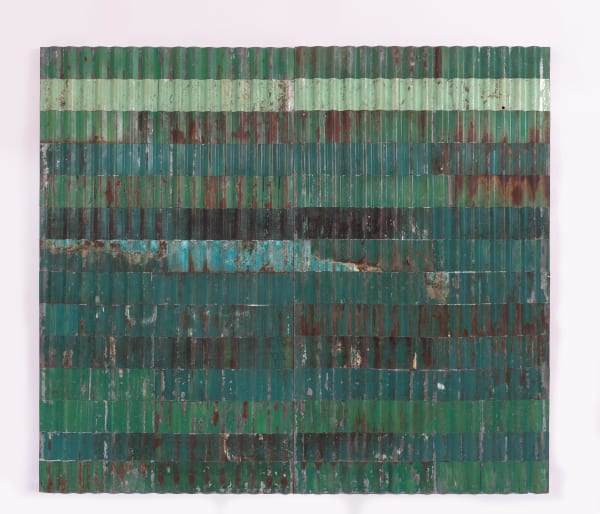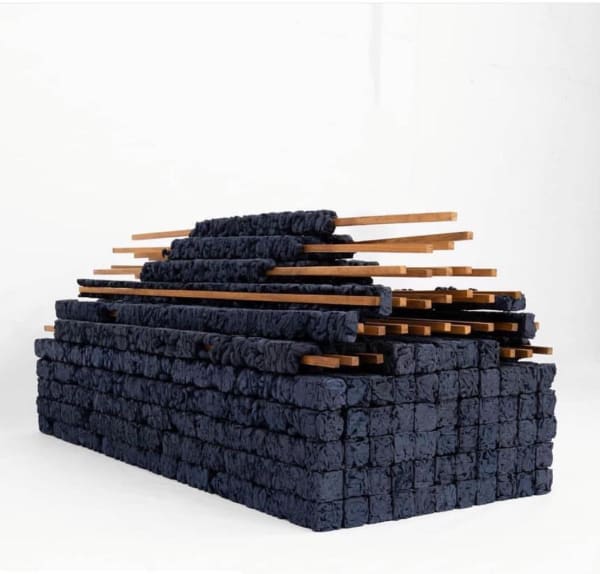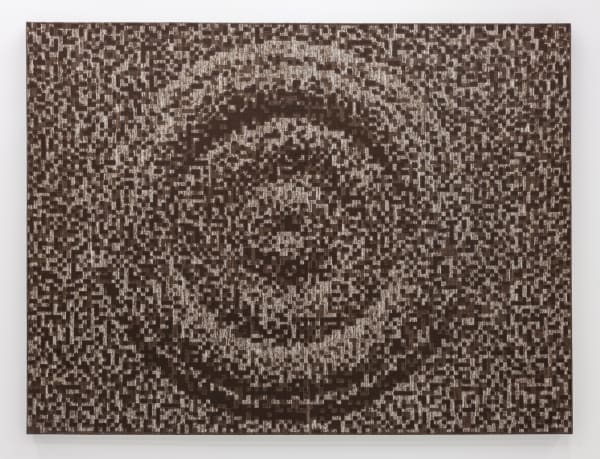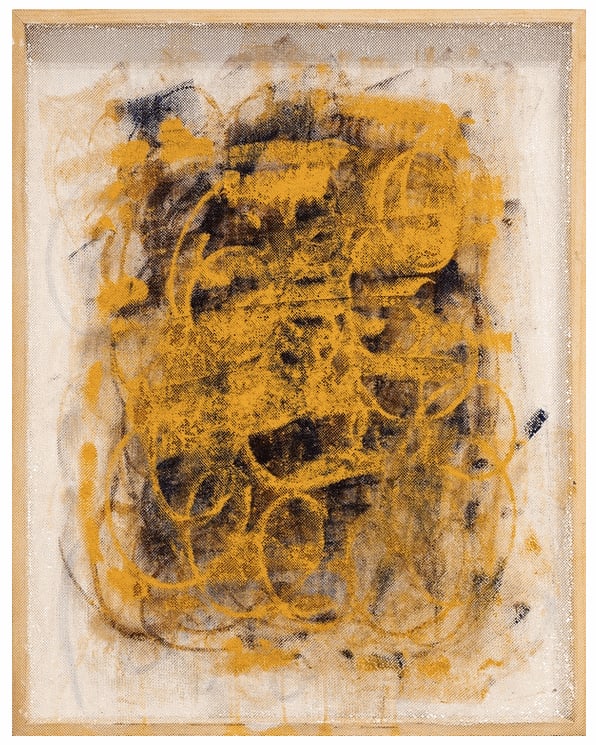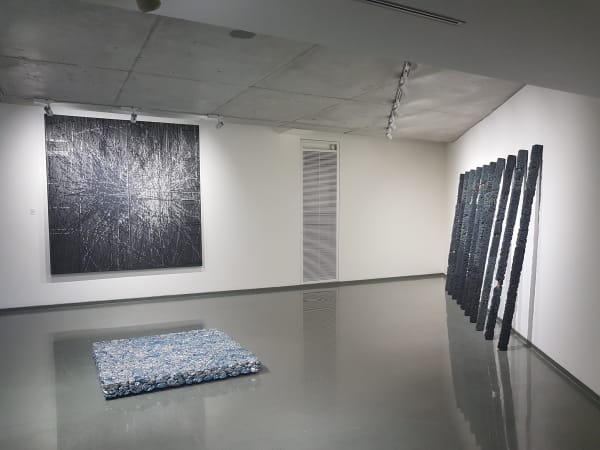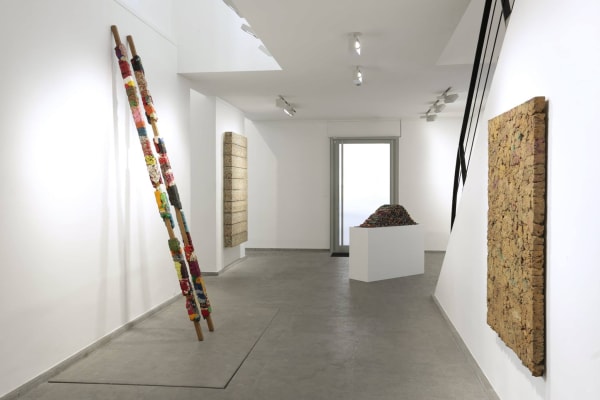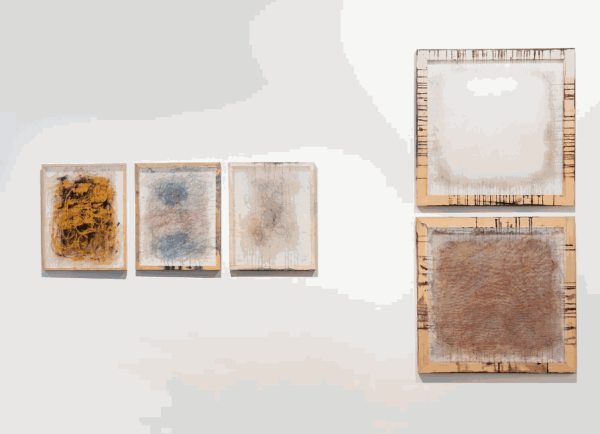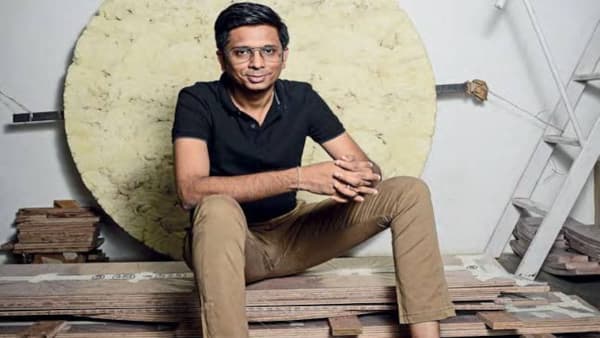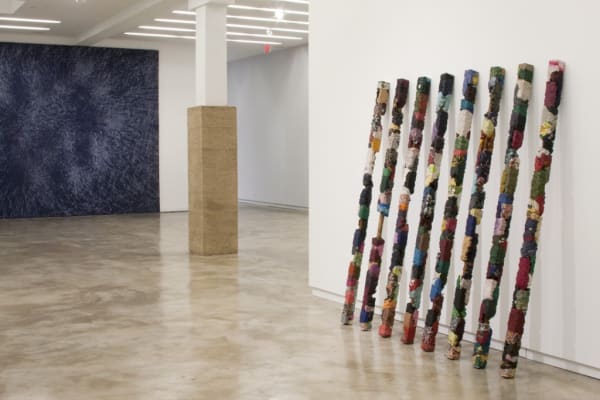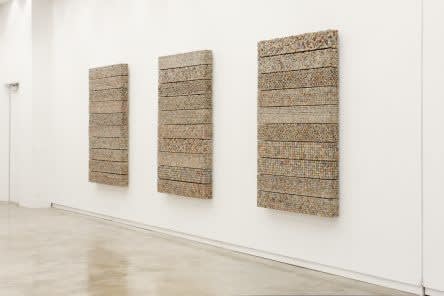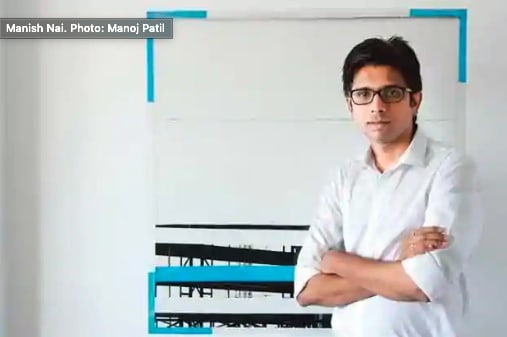Manish Nai India, b. 1980
Manish Nai is on the vanguard of contemporary abstraction. His studio practice is rooted strongly in materiality and process, especially as those elements relate to daily life in Mumbai, India, where Nai lives and works.
Nai prioritizes materials that are both modest and quintessentially interconnected to his surroundings, such as jute, newspaper, indigo dye, second hand books and clothing, and reclaimed metal and paper. He fashions these materials into elegant geometric forms, while allowing them to retain their natural textures and colors.
Many of Nai’s pieces are studies in tedious complexities, such as the long term effects of water, light, or gravity on organic materials. Nai is particularly interested in the ways materials evolve over the course of months and years. His works can be interpreted as visual expressions of the compression of time. When complete, they are presented as tightly organized units.
Nai’s use of everyday and often discarded materials alludes to social hierarchies, both in terms of artistic media and Indian social structures. Nai's use of newspapers, for example, examines the tremendous diversity and contention within Indian society—there are almost 100 newspapers in 19 different languages distributed daily in India. He soaks them, stripping them of their words, and compresses them in wooden molds, elevating the material from disposable to the rarified.
Similarly, jute is common throughout Indian society. A strong vegetable fiber, it is often woven into a durable fabric, similar to burlap; it was once used as clothing material for the poor and is now more commonly used in building construction. Nai hails from a family of jute traders, and his intimate understanding of the material is informed equally by his cultural and family background.
Nai represented India in the 9th Shanghai Biennale, Mumbai City Pavilion, Shanghai, China, and is a Pollock-Krasner Foundation Award winner. His work has been exhibited by some of the most influential institutions in the world, including Het Noordbrabants Museum, Netherlands; Fondation Fernet-Branca, Saint-Louis, France; Devi Art Foundation, Kasturbhai Lalbhai Museum, Ahmedabad, India; Bhau Daji Lad Museum, Mumbai, India; NTU Center for Contemporary Art Singapore, Gillman Barracks, Singapore; Museum of Modern Art in Warsaw, Poland; The Sculpture Park at Madhavendra Palace, Nahargrah Fort, Jaipur, India; DR. Bhau Daji Lad Museum, Mumbai, India; Art Science Museum, Singapore; Birla Academy of Art & Culture, Kolkata, India; National Gallery of Modern Art, Mumbai, India; and Beppu Museum, Beppu, Japan. Nai earned a Diploma in Drawing and Painting from the L.S. Raheja School of Art in Mumbai, India.
-
 Manish NaiManish Nai: Fondation Fernet Branca, June 10, 2017 - October 8, 2017
Manish NaiManish Nai: Fondation Fernet Branca, June 10, 2017 - October 8, 2017 -
 Manish NaiZERO, 2022Aluminum and Stainless steel120 x 648 in
Manish NaiZERO, 2022Aluminum and Stainless steel120 x 648 in
304.8 x 1645.9 cm -
 Manish NaiUntitled, 2021Metal corrugated roof, wood108 x 192 in
Manish NaiUntitled, 2021Metal corrugated roof, wood108 x 192 in
274.3 x 487.7 cm -
 Manish NaiUntitled, 2021Found rusted metal corrugated sheets84” x 96 x 2”
Manish NaiUntitled, 2021Found rusted metal corrugated sheets84” x 96 x 2” -
 Manish NaiUntitled, 2021Found rusted metal corrugated sheets84 x 96 x 2 in.
Manish NaiUntitled, 2021Found rusted metal corrugated sheets84 x 96 x 2 in.
213.4 x 243.8 x 5.1 cm -
 Manish NaiUntitled, 2019Fly screen and acrylic26 x 20 x 1 in
Manish NaiUntitled, 2019Fly screen and acrylic26 x 20 x 1 in
66 x 50.8 x 2.5 cm -
 Manish NaiUntitled, 2019Fly screen and acrylic26 x 20 x 1 in
Manish NaiUntitled, 2019Fly screen and acrylic26 x 20 x 1 in
66 x 50.8 x 2.5 cm -
 Manish NaiUntitled, 2019Fly screen and acrylic26 x 20 x 1 in
Manish NaiUntitled, 2019Fly screen and acrylic26 x 20 x 1 in
66 x 50.8 x 2.5 cm -
 Manish NaiUntitled, 2019Compressed law book and cover10 x 8 x 4 in
Manish NaiUntitled, 2019Compressed law book and cover10 x 8 x 4 in
25.4 x 20.3 x 10.2 cm -
 Manish NaiUntitled 14, 2018Old books and wood90 3/4 x 6 7/8 x 4 1/4 in
Manish NaiUntitled 14, 2018Old books and wood90 3/4 x 6 7/8 x 4 1/4 in
230.4 x 17.5 x 10.9 cm -
 Manish NaiUntitled, 2018Used clothes and aluminum80 x 3 x 3 in Each
Manish NaiUntitled, 2018Used clothes and aluminum80 x 3 x 3 in Each
Variable arrangements, colors, and poles -
 Manish NaiUntitled, 2018Indigo dyed jute and woodVariable
Manish NaiUntitled, 2018Indigo dyed jute and woodVariable -
 Manish NaiUntitled, 2018Dyed jute and wood84 x 3 x 3 in
Manish NaiUntitled, 2018Dyed jute and wood84 x 3 x 3 in
213.4 x 7.6 x 7.6 cm each, five total -
 Manish NaiUntitled 17, 2018Old books and wood90 3/4 x 6 3/4 x 4 1/4 in
Manish NaiUntitled 17, 2018Old books and wood90 3/4 x 6 3/4 x 4 1/4 in
230.4 x 17 x 10.9 cm -
 Manish NaiUntitled, 2017Aluminum48 x 48 x 3 in
Manish NaiUntitled, 2017Aluminum48 x 48 x 3 in
121.9 x 121.9 x 7.6 cm -
 Manish NaiUntitled, 2017Dyed jute84 diameter x 4 in
Manish NaiUntitled, 2017Dyed jute84 diameter x 4 in
213.36 diameter x 10.16 cmIndigo Jute -
 Manish NaiUntitled, 2016Dyed jute66 x 48 x 4 in
Manish NaiUntitled, 2016Dyed jute66 x 48 x 4 in
167.6 x 121.9 x 10.2 cm -
 Manish NaiUntitled, 2016Indigo jute, wood90 x 4 in
Manish NaiUntitled, 2016Indigo jute, wood90 x 4 in
228.6 x 10.2 cm -
 Manish NaiUntitled, 2003Collage and jute on canvas24 x 30 in
Manish NaiUntitled, 2003Collage and jute on canvas24 x 30 in
61 x 76.2 cm -
 Manish NaiUntitled, 2018Compressed natural indigo jute cloth and wood80 x 3 x 3 in
Manish NaiUntitled, 2018Compressed natural indigo jute cloth and wood80 x 3 x 3 in
203.2 x 7.6 x 7.6 cm, (each), total 91 pieces, -
 Manish NaiUntitled, 2019Compressed natural indigo jute cloth and wood, 30 total pillarsVariable arrangements and poles
Manish NaiUntitled, 2019Compressed natural indigo jute cloth and wood, 30 total pillarsVariable arrangements and poles
80 x 3 x 3 inches
203 x 7.5 x 7.5 cm -
 Manish NaiUntitled, 2019Dyed jute and wood80 x 3 x 3 in Each
Manish NaiUntitled, 2019Dyed jute and wood80 x 3 x 3 in Each
Variable arrangements, colors, and poles -
 Manish NaiUntitled, 2017Natural and dyed jute cloth, gateway tracing paper and paint on canvas
Manish NaiUntitled, 2017Natural and dyed jute cloth, gateway tracing paper and paint on canvas
(Installed in 3 vertical panels)99 1/2 x 124 1/2 in
252.7 x 316.2 cm -
 Manish NaiUntitled, 2017Mesh and milled steel72 x 144 in
Manish NaiUntitled, 2017Mesh and milled steel72 x 144 in
182.9 x 365.8 cm (triptych) -
 Manish NaiUntitled, 2017Dyed jute84 diameter x 4 in
Manish NaiUntitled, 2017Dyed jute84 diameter x 4 in
213 diameter x 10.16 cm -
 Manish NaiUntitled, 2013Compressed newspaper and wood66 x 48 x 15 in
Manish NaiUntitled, 2013Compressed newspaper and wood66 x 48 x 15 in
167.6 x 121.9 x 38.1 cm -
 Manish NaiUntitled, 2017Used clothes and wood120 x 3 x 3 in each, installation variable
Manish NaiUntitled, 2017Used clothes and wood120 x 3 x 3 in each, installation variable
304.8 x 7.6 x 7.6 cm each, installation variable -
 Manish NaiUntitled, 2009Natural and dyed jute cloth, gateway tracing paper, and paint on canvas58 x 77 in
Manish NaiUntitled, 2009Natural and dyed jute cloth, gateway tracing paper, and paint on canvas58 x 77 in
147.3 x 195.6 cm -
 Manish NaiUntitled, 2016Natural jute66 x 48 x 4 in
Manish NaiUntitled, 2016Natural jute66 x 48 x 4 in
167.6 x 121.9 x 10.2 cm
Unframed -
 Manish NaiUntitled, 2019Fly screen and acrylic40 x 40 x 1 in
Manish NaiUntitled, 2019Fly screen and acrylic40 x 40 x 1 in
101.6 x 101.6 x 2.5 cm -
 Manish NaiUntitled, 2019Fly screen and acrylic40 x 40 x 1 in
Manish NaiUntitled, 2019Fly screen and acrylic40 x 40 x 1 in
101.6 x 101.6 x 2.5 cm -
 Manish NaiUntitled, 2019Fly screen and acrylic58 x 70 x 1 in
Manish NaiUntitled, 2019Fly screen and acrylic58 x 70 x 1 in
147.3 x 177.8 x 2.5 cm -
 Manish NaiUntitled, 2019Fly screen and acrylic26 x 20 x 1 in
Manish NaiUntitled, 2019Fly screen and acrylic26 x 20 x 1 in
66 x 50.8 x 2.5 cm -
 Manish NaiUntitled, 2019Fly screen and acrylic26 x 20 x 1 in
Manish NaiUntitled, 2019Fly screen and acrylic26 x 20 x 1 in
66 x 50.8 x 2.5 cm -
 Manish NaiUntitled, 2019Fly screen and acrylic26 x 20 x 1 in
Manish NaiUntitled, 2019Fly screen and acrylic26 x 20 x 1 in
66 x 50.8 x 2.5 cm -
 Manish NaiUntitled, 2019Fly screen and acrylic26 x 20 x 1 in
Manish NaiUntitled, 2019Fly screen and acrylic26 x 20 x 1 in
66 x 50.8 x 2.5 cm -
 Manish NaiUntitled, 2019Fly screen and acrylic36 x 36 x 1 in
Manish NaiUntitled, 2019Fly screen and acrylic36 x 36 x 1 in
91.4 x 91.4 x 2.5 cm -
 Manish NaiUntitled, 2013Compressed used clothes8 x 8 x 8 in
Manish NaiUntitled, 2013Compressed used clothes8 x 8 x 8 in
20.3 x 20.3 x 20.3 cm -
 Manish NaiUntitled, 2018Compressed law book
Manish NaiUntitled, 2018Compressed law book
3 x 6 x 6 in
7.6 x 15.2 x 15.2 cm -
 Manish NaiUntitled, 2018Compressed paperback book3 x 3 x 3 in
Manish NaiUntitled, 2018Compressed paperback book3 x 3 x 3 in
7.6 x 7.6 x 7.6 cm -
 Manish NaiUntitled, 2018Compressed paperback book2 1/2 x 3 x 3 in
Manish NaiUntitled, 2018Compressed paperback book2 1/2 x 3 x 3 in
6.3 x 7.6 x 7.6 cm -
 Manish NaiUntitled, 2018Compressed paperback book6 x 3 x 3 in
Manish NaiUntitled, 2018Compressed paperback book6 x 3 x 3 in
15.2 x 7.6 x 7.6 cm -
 Manish NaiUntitled, 2018Compressed paperback book5 1/4 x 3 x 3 in
Manish NaiUntitled, 2018Compressed paperback book5 1/4 x 3 x 3 in
13.3 x 7.6 x 7.6 cm
-

Matter of Fact: Material as a Political Act
KAVI GUPTA | WASHINGTON BLVD. FL. 2 25 Apr - 10 Oct 2025These artists explore the politics of materiality, how thread, clay, pigment, and gesture can serve as acts of reclamation, resistance, and cultural continuity.Read more -

LightSpace
KAVI GUPTA | WASHINGTON BLVD. FL. 2 22 Jul - 14 Oct 2023Kavi Gupta presents Lightspace, a group exhibition examining aesthetic spaces, physical and metaphysical, within contemporary art where concepts of lightness are central to the work. In this exhibition, a lightspace...Read more -

Manish Nai, Regenerative Visions
Nature Morte | New Delhi, India 19 Sep - 24 Oct 2021Manish Nai’s artistic practice is dedicated to an engagement with materials of a diverse variety. Often using the most modest of means and the slightest of gestures, Nai questions the...Read more -

Manish Nai, Form and Void
Richard Taittinger Gallery | New York, NY 16 Jan - 28 Feb 2021In collaboration with Richard Taittinger Gallery, Kavi Gupta is pleased to present Form and Void, a solo exhibition of works by the acclaimed Mumbai artist Manish Nai. Featuring examples from several diverse facets of Nai’s transdisciplinary practice, this exhibition seeks to explore the formal and conceptual balance between absence and presence in Nai’s unique aesthetic position.Read more
-

Origins of a Perennial Bouquet - Curated by Bose Krishnamachari
Benitha Perciyal | Manish Nai | Sudarshan Shetty | Sumedh Rajendran | Tanya Goel 17 Dec 2020 - 28 Feb 2021Manish Nai received a Diploma in Drawing and Painting from the L.S. Raheja School of Art in Mumbai. Using material that is both modest and quintessentially Indian, like jute and...Read more -

Manish Nai, Art Basel Miami Beach, Meridians
Art Basel Miami Beach 2019 4 - 8 Dec 2019In the inaugural edition of the Art Basel Miami Beach Meridians sector, Kavi Gupta is honored to present a large-scale installation by Manish Nai of 100 Burma teak sticks wrapped...Read more -

Manish Nai, A History Of Gestures
Kavi Gupta | 835 W. Washington Blvd., Chicago, IL 14 Sep - 9 Nov 2019Kavi Gupta is pleased to present Manish Nai’s second solo exhibition with the gallery, A History of Gestures.Read more -

Idea Sale
Kavi Gupta | 219 N. Elizabeth St. Chicago, IL, 60607 13 Apr - 1 Jun 2019Kavi Gupta is pleased to present Idea Sale, a group exhibition of original works by Glenn Kaino, Jae Jarrell, Wadsworth Jarrell, Manish Nai, Scott Reeder, Tony Tasset, José Lerma, Jessica Stockholder, and Angel Otero.Read more -

Alchemy: Explorations in Indigo
Kasturbhai Lalbhai Museum Lalbaug | Gujarat, India 27 Jan - 1 Aug 2019India is world famous for its fine textiles, as well as for the sourcing and production of indigo , a natural dye that produces a brilliant range of blue hues....Read more -

Manish Nai, Paper City and Ghost Modernity
Galerie Mirchandani + Steinruecke | Mumbai, India 5 Dec 2018 - 7 Mar 2019Rooted in the treatment of materials that come from my immediate surrounding and environment. I began to work with jute clothe material and have continued to explore the material ever...Read more -

Manish Nai in Trees of Life, Knowledge in Material
NTU Centre for Contemporary Art Singapore 21 Jul - 30 Sep 2018NTU Centre for Contemporary Art Singapore is embarking on an inquiry into natural materials, exploring the knowledge they embody as biological forms as well as within social, geopolitical, and historical...Read more -

Manish Nai, Capturing Time
The Noordbrabants Museum | Netherlands 18 Jul - 4 Nov 2018The monographic exhibition Manish Nai: Capturing Time will open on July 28th at The Noordbrabants Museum in ‘s-Hertogenbosch, Netherlands. It will be the Indian artist’s first solo museum exhibition in the country, and will feature 12 of his recent large-scale works.Read more -

Manish Nai, Asymmetrical Objects
Curated by Tasneem Zakaria Mehta | Dr. Bhau Daji Lad Museum, Mumbai 19 Jan - 28 Mar 2018Participating artists: Atul Bhalla, Jitish Kallat, Manish Nai, Mithu Sen, Prajakta Potnis, Ranbir Kaleka, Reena Kallat, Rohini Devasher, Sahej Rahal and Shilpa Gupta. In January 2018, the Museum will complete...Read more -

Manish Nai, IN/SITU
Expo Chicago 13 - 17 Sep 2017Kavi Gupta is happy to announce Manish Nai’s participation in IN/SITU at EXPO CHICAGO 2017.Read more -

Manish Nai, Manish Nai: Fondation Fernet Branca
Kavi Gupta | St. Louis, France 10 Jun - 8 Oct 2017Kavi Gupta is pleased to announce a new self titled solo exhibition by Manish Nai at Fondation Fernet Branca.Read more -

Manish Nai, Matter as Medium
Galerie Karsten Greve | Paris, France 10 Sep - 26 Oct 2016Matter as Medium, the first solo exhibition in France of the Indian artist Manish Nai. His composite and multiform work summons a set of references and affinities from both Arte...Read more -

Manish Nai, Manish Nai
Kavi Gupta | 219 N. Elizabeth St. Chicago, IL, 60607 6 Jun - 1 Aug 2015Kavi Gupta is proud to announce an exhibition featuring a new body of work by Mumbai based artist Manish Nai. This will be Nai’s first solo exhibition in North America...Read more
-

Manish Nai: Urban Spaces | Discover top artists in a patch of green
Hindustan Times, August 19, 2022 -

Manish Nai: Artist's Diary: Art Is A Process, A Journey And A Blessing
Manish Nai, Outlook, July 15, 2022 -

Manish Nai with ARTEMORBIDA
Barbara Pavan, ARTEMORBIDA, May 13, 2022 -

Meera Menezes on Manish Nai
Meera Menezes, Artforum, January 1, 2022 -

Manish Nai's engagement with repurposed material
Rahul Kumar, Mint Lounge, March 14, 2021 -

Vida Heydari: Contemporary art’s new address in the city drawing in top talent
Ketaki Latkar-Mahajan, Hindustan Times, December 28, 2020 -

Manish Nai: Highlights From Art Basel Miami Beach’s New ‘Meridians’ Section
Sarah Cascone, artnet news, December 4, 2019 -

These Indian Artists Are Turning Waste Into Art
Kalyani Prasher, The Weather Channel, July 23, 2019 -

PAPER CITY AND GHOST MODERNITY: IN CONVERSATION WITH RANJANA STEINRUECKE
Artfervour, March 6, 2019 -

Ahmedabad has a new museum, and it’s dedicated to a shade of blue
SHAHNAZ SIGANPORIA, Vogue, February 11, 2019 -

THE ART OF SUSTAINABILITY: THIS MUMBAI-BASED ARTIST MAKES ART OUT OF WASTE
Chinki Sinha, India Today, August 16, 2018 -

DOCUMENTING THE AGE OF ANTHROPOCENE
Tejal Pandey, The Hindu, March 16, 2018 -

WHY YOU MUST CATCH ASYMMETRICAL OBJECTS AT THE DR. BHAU DAJI LAD MUMBAI CITY MUSEUM
Anil Rane, Verve, March 13, 2018 -

INTO THE BLUE: DHAKA ART SUMMIT 2018 (EXCERPT)
Ocula, February 23, 2018 -

TURN OF THE TIDE CELEBRATES 20 YEARS OF KHOJ SUPPORT FOR ARTISTS ACROSS MEDIUMS, IDEAS
Indulge Express, February 21, 2018 -

DR. BHAU DAJI LAD MUSEUM
E-FLUX, February 11, 2018 -

WHEN REUSING DISCARDED HOUSEHOLD ITEMS BECOMES ART
Dhriti Gandhi Ranjan, The Week, February 9, 2018 -

10 OF INDIA’S TOP ARTISTS COME TOGETHER FOR A MUMBAI EXHIBITION
Phalguni Desai, Vogue India, January 24, 2018 -

MANISH NAI – THE MAN IN THE BURLAP CLOAK
Gayatri Jayaraman, India Today, January 27, 2016 -

Review: Manish Nai/Kavi Gupta Gallery
Elliot Reichert, NewCity Art, July 15, 2015 -

EPISODE 511: MANISH NAI
Christopher, Bad At Sports, June 15, 2015 -

MANISH NAI EXHIBIT OPENS WITH PANEL ON INDIAN CONTEMPORARY ART
Sunthar Visuvalingam, News India Times, June 5, 2015 -

KOCHI AND CONSCIOUSNESS
Niranjan Kunwar, Huffington Post, January 8, 2015 -

A GROUND REPORT FROM INDIA’S BIGGEST ART SHOW IN KOCHI
Riddhi Doshi, Hindustan Times, December 21, 2014 -

MANISH NAI: THE PROCEDURALIST
Dhamini Ratnam, LiveMint, August 16, 2014 -

ARTWORK OF THE WEEK: MANISH NAI’S NEWSPAPER WALL AT ART BASEL IN HK
Blouin ARTINFO, May 25, 2014 -

MANISH NAI | GEOMETRY IN JUTE
Deepika Sorabjee, Live Mint.com - The Wall Street Journal, April 17, 2013
-

Untitled Art, Miami Beach 2025
3 - 7 Dec 2025The 14th Edition of Untitled Art, Miami Beach December 3 – 7, 2025 On the sands of Miami Beach Booth A61 Kavi Gupta is pleased...Read more -

Staple + Stitch Art & Print Fair
14 - 16 Nov 2025Kavi Gupta | Editions is pleased to participate in the Staple + Stitch art book and print fair, presenting a curated selection of art publications...Read more -
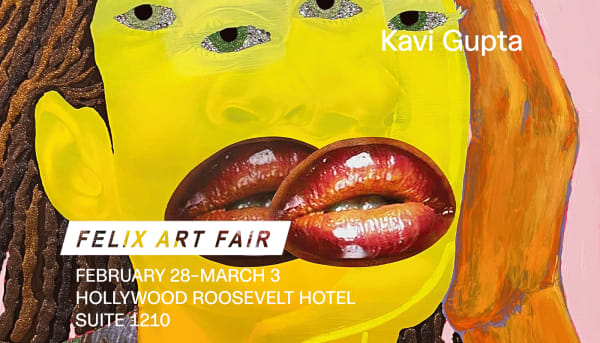
Felix Art Fair 2024
28 Feb - 3 Mar 2024Kavi Gupta is excited to return to the Felix Art Fair in Los Angeles. The historic Hollywood Roosevelt Hotel offers a unique setting in which...Read more -

Art Singapore 2023
11 - 15 Jan 2023Join us January 11-15, 2023, in Singapore for the inaugural edition of ART SG, Southeast Asia’s largest art fair. Our presentation will include a diverse...Read more -
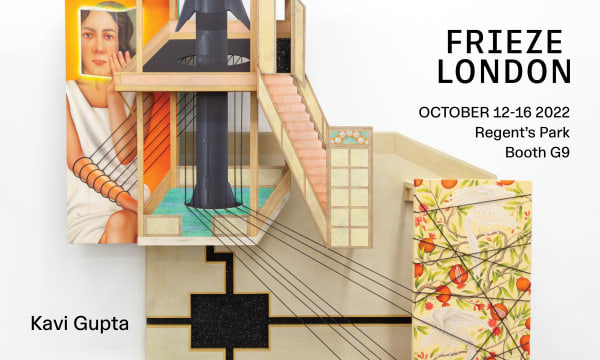
Frieze London 2022
12 - 16 Oct 2022VIP PREVIEW Wednesday, October 12 | 11 AM–7 PM OPENING HOURS Thursday, October 13 | 11 AM–7 PM Friday, October 14 | 11 AM–7 PM...Read more -
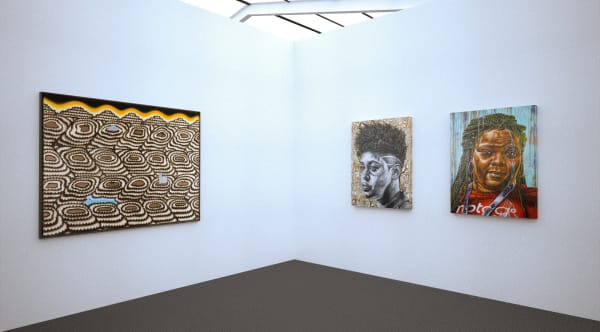
Frieze London 2020
9 - 16 Oct 2020FRIEZE LONDON ONLINE 2020 Kavi Gupta is proud to be part of Frieze London’s 2020 online viewing room. Innovative platforms like this offer us ways...Read more -

Felix Art Fair 2020
13 - 16 Feb 2020Felix LA is the brainchild of art collector Dean Valentine and art dealers Alberto and Mills Morán of LA’s Morán Morán gallery. According to organizers,...Read more -
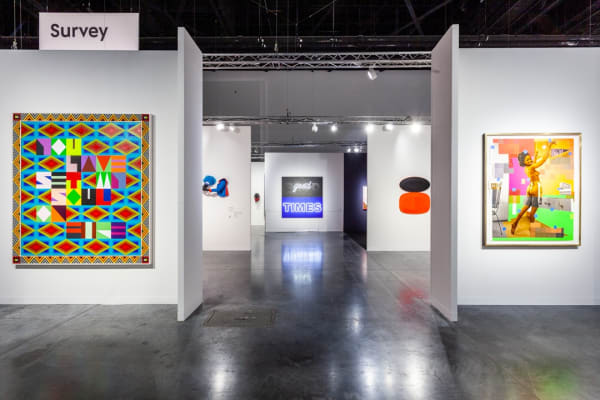
Art Basel Miami Beach 2019
4 - 8 Dec 2019Read more -

Art Basel Miami Beach Meridians 2019
4 - 8 Dec 2019In the inaugural edition of the Art Basel Miami Beach Meridians sector, Kavi Gupta is honored to present a large-scale installation by Manish Nai of...Read more -

Frieze London 2019
3 - 6 Oct 2019Read more -

Frieze New York 2019
14 - 17 Feb 2019Kavi Gupta is pleased to participate in Frieze New York. Kavi Gupta Gallery will be located at Booth B22. For more information please contact 312-432-0708.Read more -

Art Basel Miami Beach 2018
6 - 9 Dec 20182018 has been a landmark year for AFRICOBRA (African Commune of Bad Relevant Artists), which was founded in Chicago in 1968 and defined the aesthetic...Read more -

Art Basel Hong Kong 2018
29 - 31 Mar 2018For Art Basel Hong Kong 2018, Kavi Gupta will spotlight new works by a diverse selection of artists, including Beverly Fishman, Manish Nai, Jessica Stockholder,...Read more -

Art Basel Miami Beach 2017
6 - 10 Dec 2017For Art Basel Miami Beach 2017, Kavi Gupta will present an ambitious booth of original work by our distinguished international artists. With an emphasis on...Read more -

EXPO Chicago 2017
13 - 17 Sep 2017Read more -
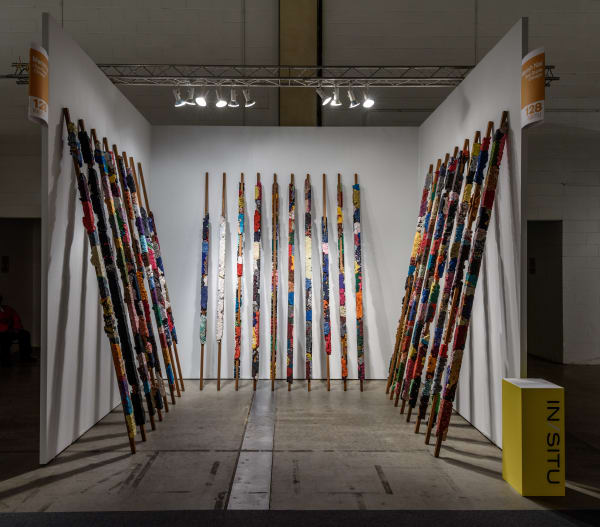
EXPO Chicago IN/SITU 2017
17 Jul 2017Kavi Gupta is happy to announce Manish Nai’s participation in IN/SITU at EXPO CHICAGO 2017. Curated by Florence Derieux, IN/SITU features large-scale, suspended sculptures and...Read more -

Art Basel Hong Kong 2017
23 - 25 Mar 2017For Art Basel Hong Kong 2017 Kavi Gupta presents a tightly curated booth built around themes of labor as autobiographical context in the creation of...Read more -
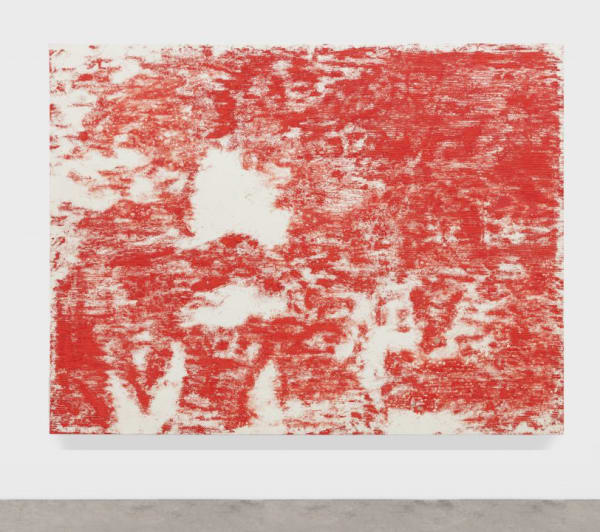
EXPO Chicago 2016
22 - 25 Sep 2016For Expo Chicago 2016, Kavi Gupta presents a booth with a heavy emphasis on new and never-before-seen works. Coinciding with the Expo Chicago fair, Kavi...Read more -

EXPO Chicago 2015
17 - 20 Sep 2015Read more -

Art Basel Miami Beach 2014
4 - 7 Dec 2014Read more
-

Staple + Stitch Art & Print Fair
14 - 16 Nov 2025Kavi Gupta | Editions is pleased to participate in the Staple + Stitch art book and print fair, presenting a curated selection of art publications...Read more -

Preview Night: Staple + Stitch Art & Print Fair
14 Nov 2025Preview night at Staple + Stitch art book and print fair will be held November 14th from 6-9pm. Editions | Kavi Gupta will be presenting...Read more -

Closing Reception: Matter of Fact: Material as a Political Act
KAVI GUPTA | WASHINGTON BLVD. FL.2 10 Oct 2025Join us for the last opportunity to see Matter of Fact: Material as a Political Act. From our earliest exhibitions to the artists we continue...Read more -

Opening Reception: Matter of Fact: Material as a Political Act
KAVI GUPTA | WASHINGTON BLVD. FL.2 25 Apr 2025Join us for the opening reception of Matter of Fact: Material as a Political Act featuring director-led tours and refreshments to celebrate the opening of...Read more -
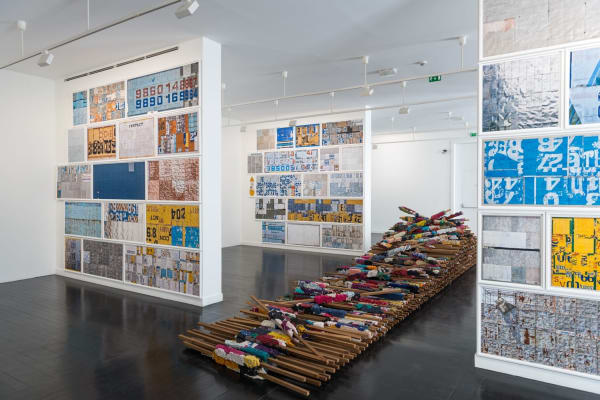
Manish Nai at Fondation Fernet Branca.
10 Jun - 8 Oct 2017Kavi Gupta is pleased to announce a new self titled solo exhibition by Manish Nai at Fondation Fernet Branca. An opening will be held on...Read more
-

Museums Without Borders: MAP x National Gallery Singapore, Manish Nai
October 22, 2021Read more -
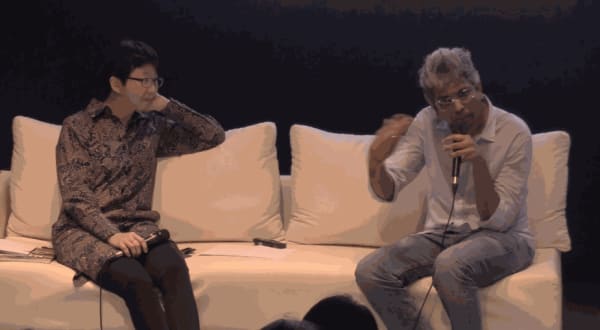
On Indigo – Manish Nai and June Yap In Conversation
September 1, 2020Read more -
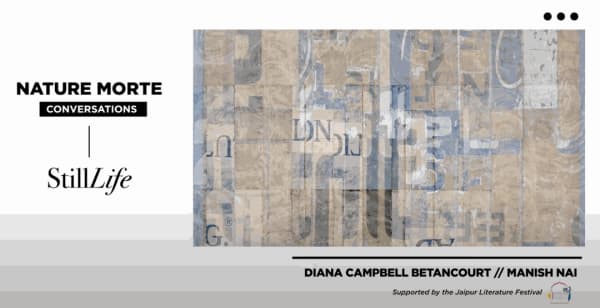
Nature Morte | Conversations: Manish Nai & Diana Campbell Betancourt
August 24, 2020Read more -

Art in Lockdown: Manish nai
June 17, 2020Art in lockdown interview with Manish Nai.Read more -
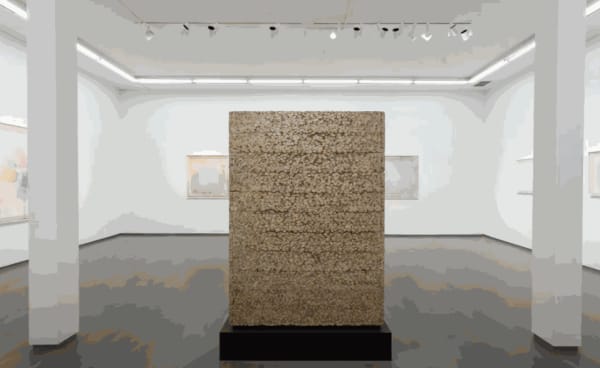
Manish Nai: A History of Gestures, at Kavi Gupta
January 22, 2020Read more -
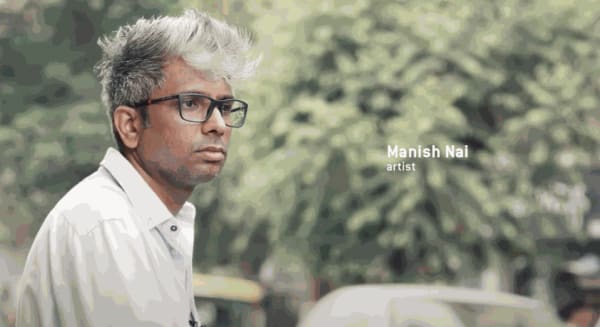
Indiase kunstenaar Manish Nai recyclet materialen
October 10, 2018Read more -

Manish Nai @NoordbrabantsMuseum
August 15, 2018Read more
-

THE WRITTEN WORD ONLINE EXHIBITION OPENS
04.24.2020The Written Word is an online exhibition examining the visual value of the verbal.Read more -

KAVI GUPTA AT ART BASEL MIAMI BEACH 2019
12.19.2019Thank you to everyone who helped us have a spectacular week at Art Basel Miami Beach 2019!Read more -

MANISH NAI FEATURED ON COVER OF ART INDIA MAGAZINE
01.29.19Manish Nai Featured in ART India MagazineRead more -
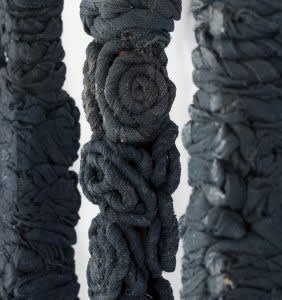
MANISH NAI FEATURED IN INAUGURAL INDIGO MUSEUM EXHIBITION
01.16.2019Manish Nai included in inaugural Indigo Museum ExhibitionRead more -

MANISH NAI AT THE NOORDBRABANTS MUSEUM
07.11.2018This summer, the Dutch will be formally introduced to the spectacular work of Manish Nai. The monographic exhibition Manish Nai: Capturing Time will open on July 28th at The Noordbrabants Museum in ‘s-Hertogenbosch, Netherlands. It will be the Indian artist’s first solo museum exhibition in the country, and will feature 12 of his recent large-scale works.Read more




